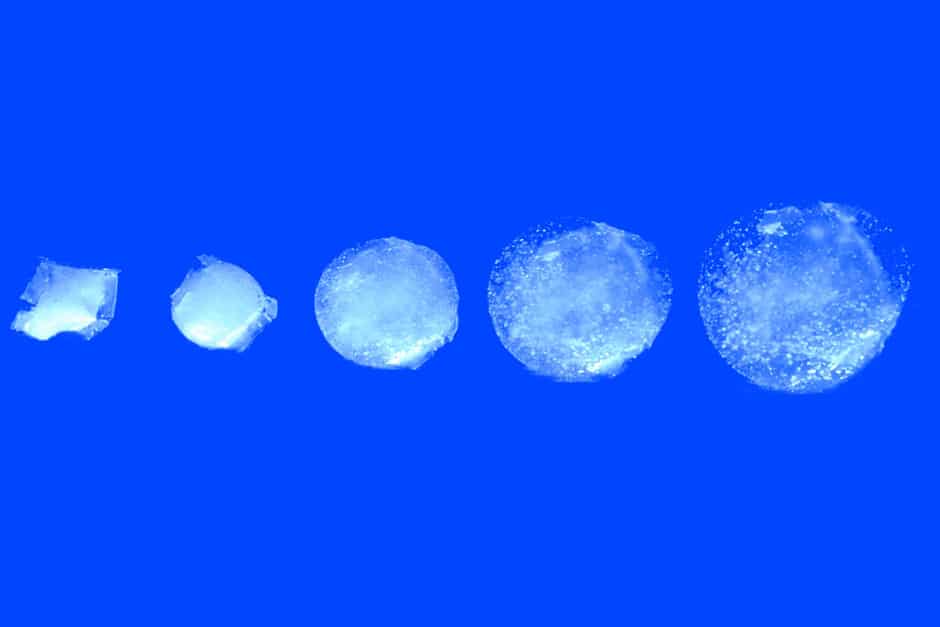Engineers at MIT have designed an ingestible sensor that swells to the size of a ping-pong ball and continuously tracks conditions in the stomach for up to 30 days.

If the pill needs to be removed from the stomach, a patient can drink a solution of calcium that triggers the pill to quickly shrink to its original size and pass out of the body.
The new pill is made from a combination of two hydrogels that quickly swell in the stomach and remain impervious to the stomach's churning acidic environment.
"The dream is to have a Jell-O-like [gelatin] smart pill, that once swallowed stays in the stomach and monitors the patient's health for a long time such as a month," said Xuanhe Zhao, associate professor of mechanical engineering at MIT.
Zhao and senior collaborator Giovanni Traverso, a visiting scientist who will join the MIT faculty in 2019, along with lead authors Xinyue Liu, Christoph Steiger, and Shaoting Lin, have published their results in Nature Communications.
The team had been looking for ways to design a hydrogel-based pill to carry sensors into the stomach and stay there to monitor vital signs or disease states for relatively long periods.
They realised that if a pill were small enough to be swallowed and passed down the oesophagus, it would also be small enough to pass out of the stomach through the pylorus. To keep it from exiting the stomach, the group would have to design the pill to quickly swell to the size of a ping-pong ball.
"Currently, when people try to design these highly swellable gels, they usually use diffusion, letting water gradually diffuse into the hydrogel network," Liu said. "But to swell to the size of a ping-pong ball takes hours, or even days. It's longer than the emptying time of the stomach."
The team’s design resembles a small, Jell-O-like capsule made from two hydrogel materials. The inner material contains sodium polyacrylate, a superabsorbent compound that swells as it soaks up liquids. A pill made from these particles alone would immediately break apart and pass out of the stomach as individual beads, so the team added a second, protective hydrogel layer to encapsulate the fast-swelling particles. This outer membrane is made from a multitude of nanoscopic, crystalline chains, each folded over another, in a nearly impenetrable, gridlock pattern.
"You would have to crack through many crystalline domains to break this membrane," Lin said. "That's what makes this hydrogel extremely robust, and at the same time, soft."
https://www.youtube.com/watch?v=UXr7dKagiAk
In the lab, the researchers submerged the pill in various solutions of water and fluid resembling gastric juices, and found the pill inflated to 100 times its original size in about 15 minutes, which is said to be much faster than existing swellable hydrogels. Once inflated, Zhao said the pill is about the softness of gelatin, yet surprisingly strong.
To test the pill's toughness, the researchers mechanically squeezed it thousands of times, at forces even greater than what the pill would experience from regular contractions in the stomach.
"The stomach applies thousands to millions of cycles of load to grind food down," Lin said. "And we found that even when we make a small cut in the membrane, and then stretch and squeeze it thousands of times, the cut does not grow larger. Our design is very robust."
The researchers further determined that a solution of calcium ions can shrink the swollen particles and trigger the pill into deflating.
Finally, Steiger and Traverso embedded small, commercial temperature sensors into several pills, then fed the pills to pigs, which have stomachs and gastrointestinal tracts very similar to humans. The team later retrieved the temperature sensors from the pigs' stool and plotted the sensors' temperature measurements over time. They found that the sensor was able to accurately track the animals' daily activity patterns up to 30 days.




Glasgow trial explores AR cues for autonomous road safety
They've ploughed into a few vulnerable road users in the past. Making that less likely will make it spectacularly easy to stop the traffic for...